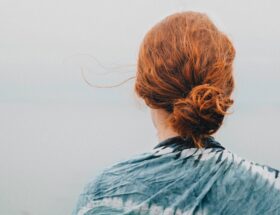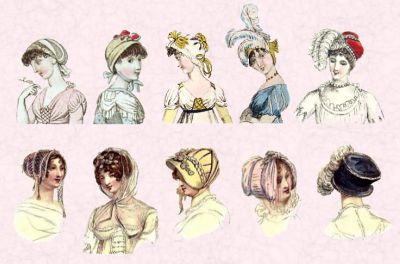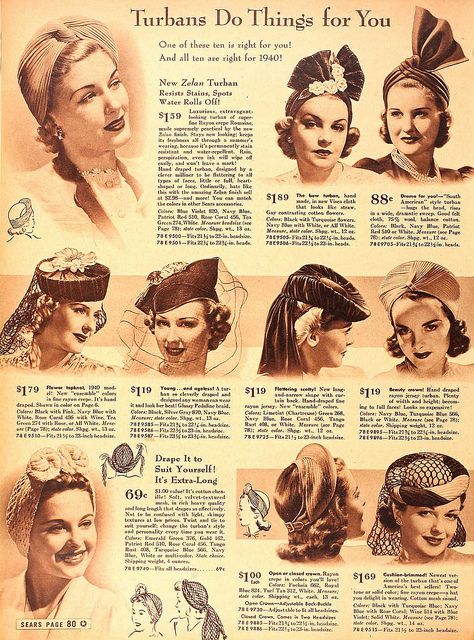By Pauline Weston Thomas for Fashion-Era.com
1625-1702 - Jacobean Ladies' Hairstyles & Headdresses
as Shown in'English Costume History by Dion Clayton Calthrop'
This costume history page is about hair fashion history. It consists of a selection of women only headdresses and hairstyles of illustrations with Calthrop's text and from Calthrop's English Costume from 1625 to 1702.
They are shown in individual Calthrop costume pages for a specific era on 36 other pages in another section of this website.
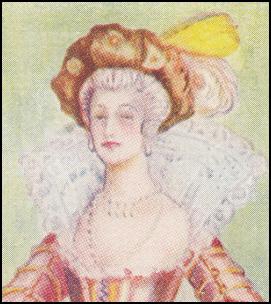
The partial text copy is from the book ENGLISH COSTUME PAINTED & DESCRIBED BY DION CLAYTON CALTHROP.
This page is about female headwear and hair styles for the era 1625-1702. Later eras of headdresses are shown on other pages. For the Introduction to this book see this introduction written by Dion Clayton Calthrop.
My comments are in italics.
Hairstyle & Dress of a Woman of the Time of Charles I Cromwell Puritan Dress - Headwear
A WOMAN OF THE TIME OF JAMES I -1603-1625
Jacobean Ladies Hairstyles
Early in the reign the high-dressed hair was abandoned, and to take its place the hair was dressed so that it was gathered up by the ears, left parted on the crown, and twisted at the back to hold a plume or feather.
Time went on, and hair-dressing again altered; the hair was now taken in four parts: first the hair was drawn well back off the forehead, then the two side divisions were curled neatly and dressed to fall over the ears, the fourth group of hair was neatly twisted and so made into a small knot holding the front hair in its place. Later on came the fringe of small curls, as in the portrait of Queen Henrietta at Windsor by Vandyck.
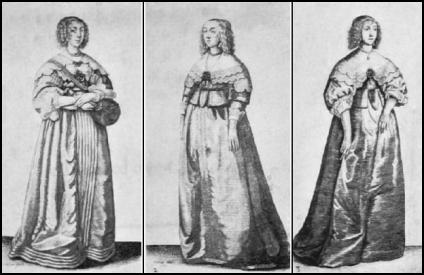
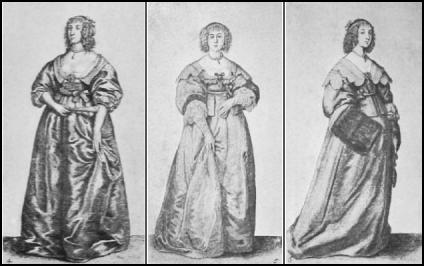
Costumes By Hollar
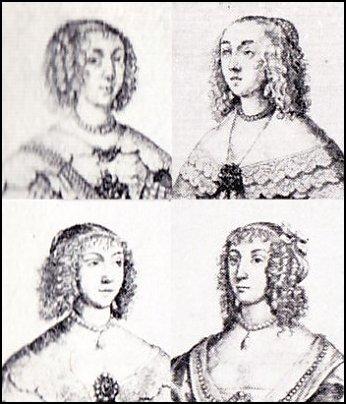
Above - Hairstyles - Illustrations by Hollar
Hairstyle & Dress of a Woman of the Time of Charles I
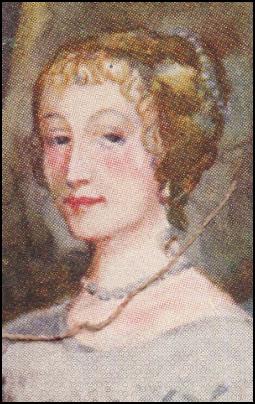
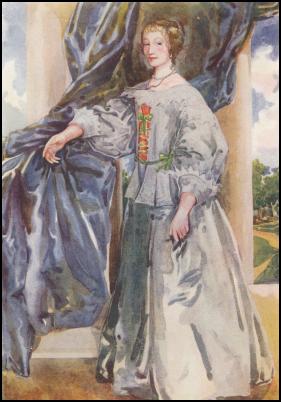
Hairstyle & Dress of a Woman of the Time of Charles I
A WOMAN OF THE TIME OF THE CROMWELLS - 1649-1660
This is not one of the most Puritanical dresses, but shows how the richness of the reign of Charles I was toned down. She carries a muff in her hand, wears a good wide collar and cuffs, and neat roses on her shoes.
This shows the modification of the dress of the time of Charles I.
Not an extreme change, but an endeavour towards simplicity.
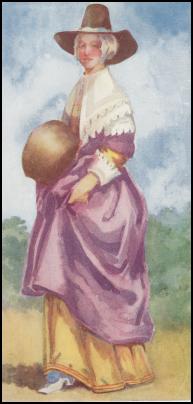
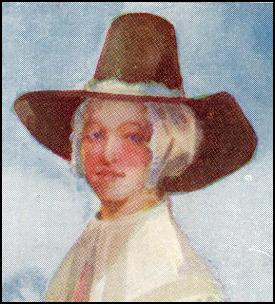
Loose Locks, Wigs and Periwigs
With the careless air that was then adopted by everybody, which was to grow yet more carefully careless in the reign of Charles II, the hair was a matter which must have undivided attention, and centuries of tight dressing had not improved many heads, so that when the loose love-locks and the dainty tendrils became the fashion, many good ladies and gentlemen had recourse to the wigmaker. In the days when to be wigless was to be undressed the perruquier was a very great person.
Fore Top Hair Loop Lock
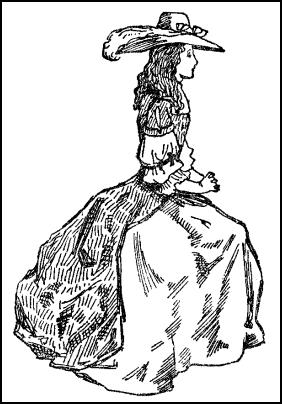
The ladies, for a time, indulged in a peculiar loop of hair on their foreheads, called a 'fore-top,' which gave rise to another fashion, less common, called a 'taure,' or bull's head, being an arrangement of hair on the forehead resembling the close curls of a bull.
The loose curls on the forehead were called 'favorites'; the long locks arranged to hang away from the face over the ears were called 'heart-breakers'; and the curls close to the cheek were called 'confidents.'
Ladies wore cloaks with baggy hoods for traveling, and for the Mall, the same hats as men, loaded with feathers.
A WOMAN OF THE TIME OF CHARLES II - 1660-1685
The costume plate shows a woman who has adopted the fair golden locks hairstyle and twirled into ringlets which are tied with a ribbon which is dressed over a frame at the sides.
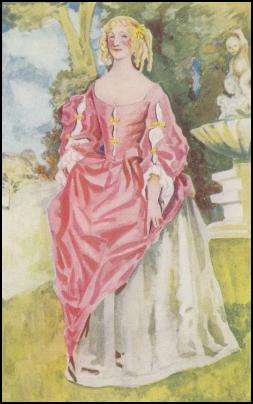
Ladies Costume - Time of Charles II
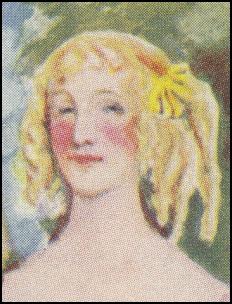
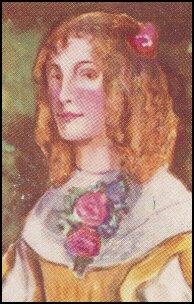
A WOMAN OF THE TIME OF WILLIAM AND MARY - 1689-1702
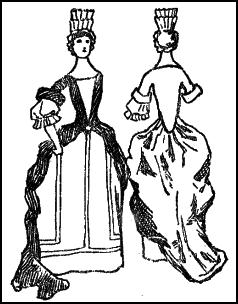
Here you see the cap called the 'fontage,' the black silk apron, the looped skirt, and the hair on the high frame called a 'commode.'
'We see her coming afar off; against the yew hedge her weeds shine for a moment. We see her figuretto gown well looped and puffed with the monte-la-haut. Her échelle is beautiful, and her pinner exquisitely worked. We can see her commode, her top-not, and her fontage, for she wears no rayonné.
A silver pin holds her meurtriers, and the fashion suits better than did the crève-cœurs. One hand holds her Saxon green muffetee, under one arm is her chapeau-bras. She is beautiful, she needs no plumpers, and she regards us kindly with her watchet eyes.'
'The hat is a paille d'Italie trimmed with a profusion of pink roses, accompanied by a pink chiffon ruffle fashioned into masses bouillonnée arranged at intervals and circled with wreaths of shaded roses.'
The modern terms so vaguely used are shocking, and the descriptive names given to colours by dress-artists are horrible beyond belief - such as Watteau pink and elephant grey, not to speak of Sèvres-blue cherries.
However, the female mind delights in such jargon and hotch-potch.
Weeds
'Weeds' is a term still in use in 'widow's weeds,' meaning the entire dress appearance of a woman.
Commode, Top-Not, Fontage Tower

The 'commode' is the wire frame over which the curls are arranged, piled up in high masses over the forehead.
The 'top-not' is a large bow worn at the top of the commode; and the 'fontage' or 'tower' is a French arrangement of alternate layers of lace and ribbon raised one above another about half a yard high.
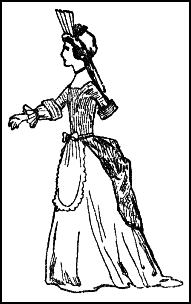
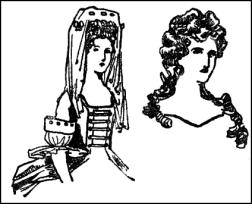
It was invented in the time of Louis XIV, about 1680, by Mademoiselle Fontage.
This costume history page is about hair fashion history. It consists of a selection of women only headdresses and hairstyles of illustrations with Calthrop's text and from Calthrop's English Costume from 1625 to 1702. They are as shown in individual Calthrop costume pages for a specific era on 36 other pages in another section of this website. The partial text copy is from the book ENGLISH COSTUME PAINTED & DESCRIBED BY DION CLAYTON CALTHROP. Full text is on the individual dated pages.
This page is about female headdresses and hairstyles dresses for the era 1625-1702. Later eras of headdresses are shown on other pages. For the Introduction to this book see this introduction written by Dion Clayton Calthrop. My comments are in italics.
Page Added January 2011. Ref:-P774.
